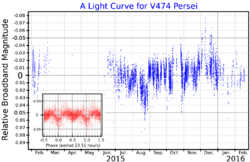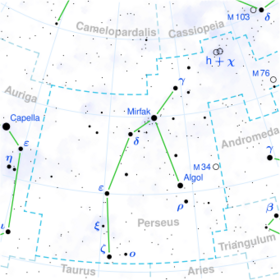Astronomy:9 Persei
| Observation data Equinox J2000.0]] (ICRS) | |
|---|---|
| Constellation | Perseus |
| Right ascension | 02h 22m 21.43482s[1] |
| Declination | 55° 50′ 44.3518″[1] |
| Apparent magnitude (V) | 5.15 - 5.25[2] |
| Characteristics | |
| Spectral type | A2 Ia[3] |
| U−B color index | −0.11[4] |
| B−V color index | +0.37[4] |
| Variable type | α Cyg[2] |
| Astrometry | |
| Radial velocity (Rv) | −15.20[5] km/s |
| Proper motion (μ) | RA: +0.374[1] mas/yr Dec.: −1.798[1] mas/yr |
| Parallax (π) | 0.7603 ± 0.1139[1] mas |
| Distance | approx. 4,300 ly (approx. 1,300 pc) |
| Absolute magnitude (MV) | −4.73[6] |
| Details | |
| Mass | 10.5[7] M☉ |
| Radius | 88.9+3.8 −2.8[1] R☉ |
| Luminosity | 12,331±2,189[1] L☉ |
| Surface gravity (log g) | 1.74[8] cgs |
| Temperature | 9,840[9] K |
| Metallicity [Fe/H] | +0.26[8] dex |
| Rotational velocity (v sin i) | 25[3] km/s |
| Other designations | |
| Database references | |
| SIMBAD | data |

9 Persei is a single[11] variable star in the northern constellation Perseus, located around 4,300 light years away from the Sun. It has the Bayer designation i Persei; 9 Persei is the Flamsteed designation. This body is visible to the naked eye as a faint, white-hued star with an apparent visual magnitude of about 5.2. It is moving closer to the Sun with a heliocentric radial velocity of −15.2 km/s.[5] The star is a member of the Perseus OB1 association of co-moving stars.[12]

This is a blue supergiant with a stellar classification of A2 Ia,[3] a massive star that has used up its core hydrogen and is now fusing heavier elements. It is an Alpha Cygni variable (designated V474 Persei), a type of non-radial pulsating variable. It ranges in magnitude from 5.15 down to 5.25.[14] The star has 10.5[7] times the mass of the Sun and has expanded to 89[1] times the Sun's radius. It is radiating over 12,000[1] times the luminosity of the Sun from its swollen photosphere at an effective temperature of 9,840 K.[9]
9 Persei has one visual companion, designated component B, at an angular separation of 12.3″ and magnitude 12.0.[15]
References
- ↑ 1.0 1.1 1.2 1.3 1.4 1.5 1.6 1.7 1.8 Brown, A. G. A. (August 2018). "Gaia Data Release 2: Summary of the contents and survey properties". Astronomy & Astrophysics 616: A1. doi:10.1051/0004-6361/201833051. Bibcode: 2018A&A...616A...1G. Gaia DR2 record for this source at VizieR.
- ↑ 2.0 2.1 Samus, N. N. et al. (2009). "VizieR Online Data Catalog: General Catalogue of Variable Stars (Samus+ 2007-2013)". VizieR On-line Data Catalog: B/GCVS. Originally Published in: 2009yCat....102025S 1. Bibcode: 2009yCat....102025S.
- ↑ 3.0 3.1 3.2 Hoffleit, D.; Warren, W. H. (1995). "VizieR Online Data Catalog: Bright Star Catalogue, 5th Revised Ed. (Hoffleit+, 1991)". VizieR On-line Data Catalog: V/50. Originally Published in: 1964BS....C......0H 5050. Bibcode: 1995yCat.5050....0H.
- ↑ 4.0 4.1 Ducati, J. R. (2002). "VizieR Online Data Catalog: Catalogue of Stellar Photometry in Johnson's 11-color system". CDS/ADC Collection of Electronic Catalogues 2237. Bibcode: 2002yCat.2237....0D.
- ↑ 5.0 5.1 Wilson, R. E. (1953). "General Catalogue of Stellar Radial Velocities". Carnegie Institute Washington D.C. Publication (Carnegie Institution for Science). ISBN 9780598216885. Bibcode: 1953GCRV..C......0W.
- ↑ Huang, W. et al. (2012), "A catalogue of Paschen-line profiles in standard stars", Astronomy & Astrophysics 547: A62, doi:10.1051/0004-6361/201219804, Bibcode: 2012A&A...547A..62H.
- ↑ 7.0 7.1 Tetzlaff, N.; Neuhäuser, R.; Hohle, M. M. (2011). "A catalogue of young runaway Hipparcos stars within 3 kpc from the Sun". Monthly Notices of the Royal Astronomical Society 410 (1): 190–200. doi:10.1111/j.1365-2966.2010.17434.x. Bibcode: 2011MNRAS.410..190T. Vizier catalog entry
- ↑ 8.0 8.1 Wu, Yue; Singh, H. P.; Prugniel, P.; Gupta, R.; Koleva, M. (2010). "Coudé-feed stellar spectral library – atmospheric parameters". Astronomy & Astrophysics 525: A71. doi:10.1051/0004-6361/201015014. Bibcode: 2011A&A...525A..71W.
- ↑ 9.0 9.1 Zorec, J.; Cidale, L.; Arias, M. L.; Frémat, Y.; Muratore, M. F.; Torres, A. F.; Martayan, C. (2009). "Fundamental parameters of B supergiants from the BCD system". Astronomy and Astrophysics 501 (1): 297–320. doi:10.1051/0004-6361/200811147. Bibcode: 2009A&A...501..297Z.
- ↑ "9 Hya". SIMBAD. Centre de données astronomiques de Strasbourg. http://simbad.u-strasbg.fr/simbad/sim-basic?Ident=9+Hya.
- ↑ Eggleton, P. P.; Tokovinin, A. A. (September 2008), "A catalogue of multiplicity among bright stellar systems", Monthly Notices of the Royal Astronomical Society 389 (2): 869–879, doi:10.1111/j.1365-2966.2008.13596.x, Bibcode: 2008MNRAS.389..869E.
- ↑ Lee, Hsu-Tai; Lim, Jeremy (June 2008). "On the Formation of Perseus OB1 at High Galactic Latitudes". The Astrophysical Journal 679 (2): 1352–1363. doi:10.1086/587801. Bibcode: 2008ApJ...679.1352L.
- ↑ Burggraaff, O.; Talens, G. J. J.; Spronck, J.; Lesage, A. L.; Stuik, R.; Otten, G. P. P. L.; Van Eylen, V.; Pollacco, D. et al. (September 2018). "Studying bright variable stars with the Multi-site All-Sky CAmeRA (MASCARA)". Astronomy and Astrophysics 617: A32. doi:10.1051/0004-6361/201833142. Bibcode: 2018A&A...617A..32B.
- ↑ Samus, N. N. et al. (2017), "General Catalogue of Variable Stars", Astronomy Reports, 5.1 61 (1): 80–88, doi:10.1134/S1063772917010085, Bibcode: 2017ARep...61...80S.
- ↑ Mason, Brian D.; Wycoff, Gary L.; Hartkopf, William I.; Douglass, Geoffrey G.; Worley, Charles E. (2001). "The 2001 US Naval Observatory Double Star CD-ROM. I. The Washington Double Star Catalog". The Astronomical Journal 122 (6): 3466. doi:10.1086/323920. Bibcode: 2001AJ....122.3466M. Vizier catalog entry
 |


